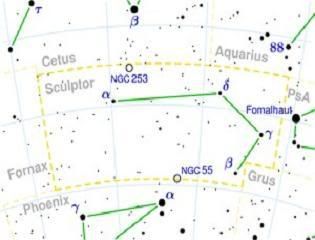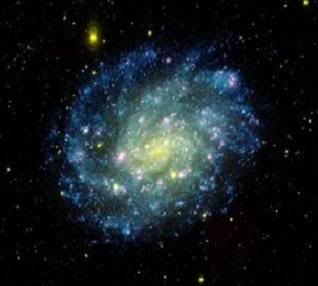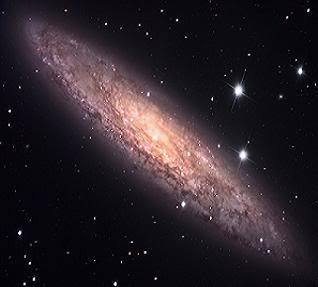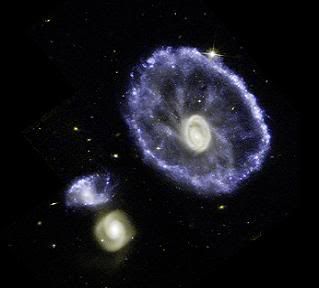Post by glactus on Feb 17, 2008 5:39:16 GMT

Sculptor, which takes up a large but obscure region of the sky, was originally named L' Atelier du Sculpteur (the Sculptor's Workshop), but like many other of Lacaille's constellations, the name was shortened and became the Sculptor. This minor constellation can be found just east of Fomalhaut, alpha PsA. The constellation has only stars finer than fifth magnitude, and is lying at the farthest region from the Milky Way. As it was introduced during the 17th century, Sculptor has no mythology associated with it.
Notable stars:
S Sculptoris
S Sculptoris is a bright Myra - type variable star ranging from 5.5 to 13.6 magnitude. It has a period of 362.6 days, which means that it brightens up at just about the same time every year. Distance from Earth is 326 light years.
Lambda Sculptoris
Lambda Sculptoris is a binary star approximately 432 light years from Earth. The primary component is a blue-white B-type main sequence dwarf with an apparent magnitude of 6.7. The companion is an A-type star with an apparent magnitude of 7.0. Together they have an apparent magnitude of 6.05.
Tau Sculptoris
Tau Sculptoris is a birany approx. 202 light years from Earth. The primary component Tau Sculptoris a is a white - yellow main sequence f type dwarf with an apparent magnitude of 6.0. The companion is of manitde 7.1. They both have an apparent combined magnitude of 5.69.
Kappa - 1 Sculptoris
Kappa-1 Sculptoris is a triple star system approximately 224 light years from Earth. It contains a binary pair, Kappa-1 Sculptoris A and B which are both yellow-white F-type giants with an apparent magnitudes of 6.2 and 6.3. Together they shine at a combined magnitude of 5.42, and are orbited by an 18th magnitude star 70 arcseconds distant.
Notable objects:

NGC 300
Located some 7 million light-years away, the spiral galaxy NGC 300 is a beautiful representative of its class, a Milky-Way-like member of the prominent Sculptor group of galaxies in the southern constellation of that name. NGC 300 is a big object in the sky - being so close, it extends over an angle of almost 25 arcmin, only slightly less than the size of the full moon. It is also relatively bright, even a small pair of binoculars will unveil this magnificent spiral galaxy as a hazy glowing patch on a dark sky background. Magnitude is 9.0

NGC 253
The Sculptor Galaxy (NGC 253) is an intermediate spiral galaxy in this constellation. It is a starburst galaxy, which means that it is currently undergoing a period of intense star formation. NGC 253 is the brightest member of the Sculptor group of galaxies, which is grouped around the South galactic pole, and was one of the major discoveries of Caroline Herschel, the sister of William Herschel. She discovered this object on September 23, 1783. Magnitude is 7.3 and distance from earth is 10 milion light years.

ESO 350-40
This image of the Cartwheel Galaxy was taken by the Hubble Space Telescope in blue band visible light. This streucture is a lenticular galaxy about 500 million light-years away in this constellation, and is about 150,000 light-years across. The galaxy was once a normal galaxy like the Milky Way before it underwent a head-on collision with a nearby galaxy. Magnitude is 15.2.

NGC 55
An absolutely spectacular edge on spiral galaxy that even 40x gives an outstanding view. As the brightest galaxy in the Sculptor galaxy group, NGC 55 is a must see object, and would be truly stunning in a large aperture telescope. It is a fine example of an edge-on barred spiral galaxy of the Magellanic type. This type SB member is around 5 million light years distant, with a magnitude of about 7.8.

whispers
credits:
Sculptor map: Wikipedia
en.wikipedia.org/wiki/Sculptor_(constellation)
image: NGC 300: Wikipedia
en.wikipedia.org/wiki/NGC_300
image: NGC 253:spacsun
spacsun.rice.edu/~has/images/LO_NGC-253-W_9_20.jpg
image: ESO 350-50 Cartwheel galaxy: NASA/STScI
chandra.harvard.edu/photo/2006/cartwheel/more.html
image: NGC 55: noao
www.noao.edu/noao/staff/rector/digital/ngc55/index.html


